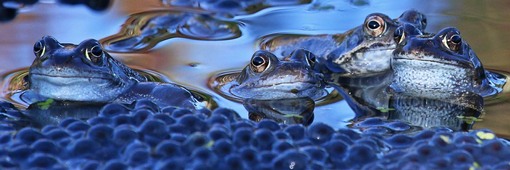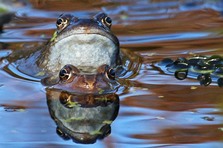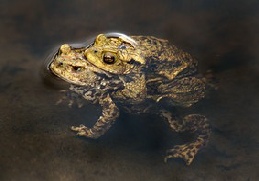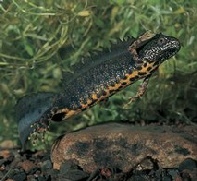

Biodiversity
Action
Plan

Amphibians. Although frogs, toads and newts lay their eggs in water and their larvae (tadpoles) develop there, outside the breeding season adults and juveniles spend much of their time on land foraging, sheltering and hibernating.
Sensitive to their environment, amphibian populations have declined and have been lost in many places, especially Common Toad and Great Crested Newt.
Five of Britain's seven native amphibian species are found in Barnsley: Great Crested Newt and Common Toad, both national priority species because of the severity of their decline, and Common Frog, Smooth Newt and Palmate Newt.
Common Frog is the most widespread and common amphibian and tends to be associated with fish-free, shallow-edged pools for breeding producing clumps of frog-spawn, often using garden ponds.
Common Toad has a drier, warty skin with a blunt nose, in contrast to the smooth moist skin of the frog. Toads crawl whereas frogs jump in a faster movement. Common toads prefer deeper water bodies than frogs in which to breed and have strings of toad-spawn.
Toads, sensitive to changes in habitat, are more selective than frogs, more ‘site-faithful' and more at risk: destruction of a toad breeding pond can eliminate the species over a large area. They are ‘near threatened’ with extinction.
Great Crested Newts are considerably larger than our other two native newt species, dark brown or black with a distinct ‘warty’ skin and bright orange blotchy underneath. Strictly protected following a massive historic decline, there are signs of recent improvements but they remain at risk. Good populations are found in Barnsley at several sites.
Smooth Newt. Although the most widespread newt, Smooth Newt has declined in numbers; good populations are found in suitable habitats across Barnsley.
Palmate Newt has only been recorded locally in the Wharncliffe Wood area.
For further information on Great Crested Newt and district licensing, and on conservation, and actions for amphibians, follow these links …
Amphibian & Reptile Conservation ‘Red List’ assessment in England in 2021 focused on the current risk of extinction of species.
It assessed Common Toad as ‘Near Threatened’ with extinction. It has had substantial declines at national and regional level over the last 30 years,
The assessment does not consider Great Crested Newt as currently threatened (or near threatened) with extinction.
Great Crested Newt had a considerable population loss in the twentieth century, but rates of decline have been much lower in recent decades.
However GCN populations have not recovered to former numbers and its current status can not be considered favourable,
ARC Trust Red list report 2021


Local Priority Species include the national priority species:
- Common Toad, Bufo bufo
- Great Crested Newt Triturus cristatus.
These are both UKBAP 2007 priority species and Section 41 species of principal importance.
These are local priority species due to their national status and because there are sites in Barnsley with good populations.
Sites with good assemblages of amphibian species including the Common Frog and other newts, are also a local priority:
- Common Frog, Rana temporaria
- Smooth Newt,Lissotriton vulgaris.
- Palmate Newt,Lissotriton helveticus

Amphibian species